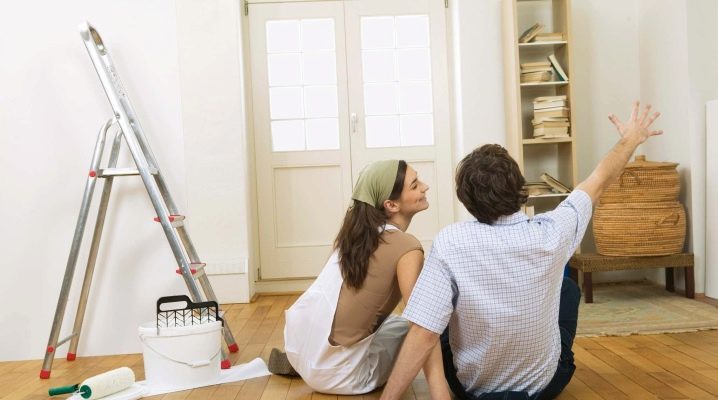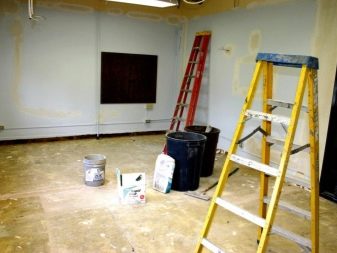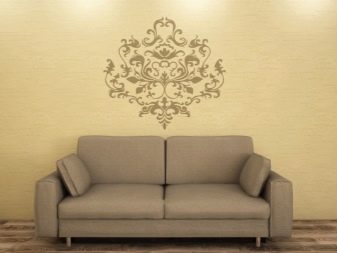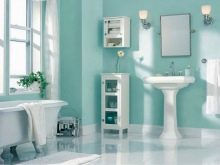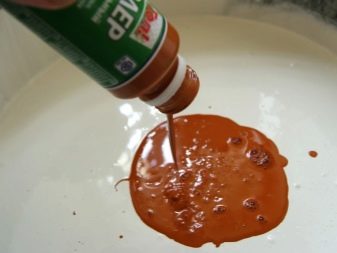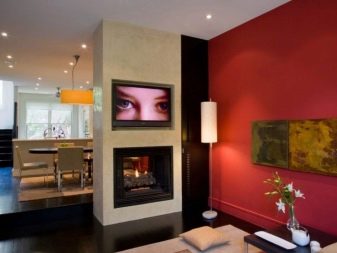How to paint the walls in the apartment: do the repair yourself
Today, wall decoration using staining is very popular. This method is budget and easy to create the comfort of your own interior. Before you carry out finishing work, it is recommended to get acquainted with the technique of painting the walls in the room in order to enjoy the result in the future.
Where to begin?
Starting to paint the walls in the apartment with your own hands, you need to consider some of the nuances and recommendations of experts:
- The first thing you need to measure the area of color. This is necessary in order not to be mistaken with the acquired amount of paint.
- It is necessary to properly prepare the basis for staining using special technology.
- The paint is applied in a thin layer, otherwise it may swell.
Paint selection
It is necessary to get acquainted with the recommended indicators of a product.
It must meet certain requirements, including:
- Security.
- Environmental friendliness.
- Optimum drying time.
- Acceptable price.
The choice of paint depends on the type of original surface and the place of application of the paint. Indeed, in the bathroom fit waterproof paint. For the kitchen, it is better to use paint with wear-resistant qualities, since the surface of the wall is exposed to constant dirt. For a hallway and a corridor, an abrasion resistant version is needed.
Very popular with customers enjoys:
Oily
Oil paints are products based on linseed oil. The advantages of this type of paint are high wear resistance and moisture resistance. It is recommended to use such material in bathrooms, kitchens. The service life can last more than seven years, but this is possible only with proper care.
The only drawback of oil paint is an unpleasant pungent odor that will erode long enough.
Water emulsion
The composition of water-based coloring materials based on polyvinyl acetate emulsion. Such a finish has a number of advantages: it is an environmentally friendly product that is safe to use, it is distinguished by a variety of different color shades, ease of use, quick drying of painted areas. This is recommended to paint the walls in apartments and houses where there are small children or allergies. There is one drawback: the application is possible at a temperature of +5 degrees.
According to their characteristic qualities, water-based paints are divided into:
Acrylic
Some types of such paint are suitable for painting ceramic tiles in bathrooms, the composition of the coloring material allows you to wipe the walls with a wet cloth. Due to its composition, this material can be used when painting MDF, brick, wood, glass.
Silicone
Silicone coating has good air permeability. Such material can be washed with special detergents.
This coating can be applied to the wall with small sizes of defects (up to 2 mm.), Hiding all the irregularities.
Latex
Latex materials are the most moisture resistant.Surfaces after dyeing and drying are not exposed to water, while remaining intact. The only drawback of this product is an unpleasant smell during painting.
Mineral
Mineral water-emulsion varieties are resistant to pollution. It is convenient to apply such a composition on the surface of the walls of brick, concrete, or plaster. Slaked lime and cement in the composition help to better adhere the paint to the working surface.
Colors and design
A large number of color solutions allow you to realize creative thoughts, creating a unique interior in the apartment. Chameleon paints, which have mother-of-pearl in their composition, create unusual effects under different lighting conditions. From the side you might think that the walls are covered with silk fabric. Make coloring materials with the effect of velvet, they are composed of solid colored particles of various materials (sand, seashells, minerals, stones). After applying such a product on the surface, the effect of a velor canvas is created.
Manufacturers to improve the decoration add sparkles of a variety of decorations,allowing to achieve originality and magic of the interior.
As for colors, the possibilities of coloring compositions are unlimited. They obey a particular style of the room, a general background, or contrast with it. White paint is the most popular: this color is universal, through it you can highlight any area of the room, giving it uniqueness, filling the space with light. Especially this shade is valuable in the interiors of stylistics, replete with woody massif. In such a space, one cannot do without selecting planes, otherwise the texture of the tree will lose expressiveness. In this case, white paint is appropriate to highlight the ceiling.
The most valuable shades of colors today are natural, close to the beige-brown tones. They allow to improve the texture of the wooden floor. For the walls of the bathroom should be used blue, sea, sand shades. A great solution would be to decorate the accent zone with a simple pattern using paints. At the same time, the shades of the material can be different: by adding a color scheme today, you can choose the perfect tone.
Quantity calculation
Before painting the walls you need to calculate the amount of coloring material:
- First of all, measure the area of the painted surface (it is recommended to measure together with window and door openings, thereby making a stock).
- The accuracy of the calculation depends on the number of layers of paint applied.
- Multiply the length by the width of the area, then correlate it with the indicated consumption on the packaging of the paint itself. Usually the manufacturer indicates how square. m. working surface missing volume of one can.
- To the resulting consumption add another 15% of the material for unforeseen expenses. This will eliminate the disadvantage (it is not always possible to perfectly find the missing material).
Surface preparation
Preparation of walls for painting is an excellent opportunity to eliminate all defects and irregularities of the wall surface. Before the start of finishing works it is necessary to free the room from furniture and decorative objects. The furniture is taken out of the room, or closed with a special film. The floors are covered with newspapers or cardboard.
All decor items on the walls must be removed, this will eliminate the appearance of splashes of coloring matter.
The surface of the walls should be cleaned from various impurities with a stiff brush (dirt, dust, plaster solutions). The existing cracks and crevices are carefully sealed with a putty or plaster mix with a spatula, after which these areas are leveled with emery paper until glossy. If the surface has an old paint coat, it must be scraped off. Wallpaper coating can be removed by pre-wetting with water. If the wallpaper is firmly glued without moving away elements, you can not remove them, performing painting directly on them. After removing the wallpaper, the wall must be washed with water and detergent. Waterproof wallpaper is much harder to remove: to moisten them, you need to make an incision in a certain place for pouring water.
Before painting it is necessary to treat the surface with a primer. This will provide better adhesion to the surface. It is necessary to apply 1-2 coats of primer over the entire painted area, avoiding the appearance of dull traces. This applies not only to concrete surfaces, but also to plasterboard walls.
If the wall is in good condition without flaws, you can simply wash it and vacuum it.Painting the wall should be started after the primer is completely dry (the time can vary from 2 hours to a day). The final step in the preparation of the walls is the disconnection of electricity from the network.
It is recommended to cover sockets and switches with mounting tape or tape.
Painting technology
For the internal painting of the walls in the apartment mainly use water-based paint.
It meets all the necessary quality indicators, differing:
- short drying time;
- security;
- a variety of shades;
- ease of use.
Before painting it is necessary to stock up with the most necessary:
- paint;
- masking tape;
- protective gloves and goggles;
- brush and roller;
- tray for coloring material.
Before applying the painting composition on the walls it is necessary to add color to the finishing material. It is better to plant all the paint, otherwise it will not be possible to create the same color in all containers. In a prepared container with a mixer or manually, paint should be diluted with water (if it is thick) to obtain a uniform consistency, then you need to add colorings in small portions.Gradually adding color will allow you to choose the desired shade as accurately as possible to the desired.
If it is necessary to tint a small section of the wall or apply multi-colored stripes, masking tape is used for even separation. To stick it evenly, use a level (laser or alcohol). The height of sticking depends on individual tastes and preferences. Masking tape must be glued firmly without air pockets, otherwise the paint will flow, and the line will turn out uneven.
It is recommended to start painting walls with doorways or windows with a small roller. When applying oil paint is better to use different brushes with natural bristles. In order not to stain the door materials, it is better to paint over the edges with a small brush. To obtain smooth lines in the field of electrical appliances used small brushes. After applying the paint on the problem areas and corners of the room, you can go to the rest of the wall surfaces.
Painting the walls is done with a large roller. Try to apply the coloring material in a uniform layer, avoiding drips and drops. The movement of the roller must be vertical.As soon as gaps appear, it is time to dip the roller in the paint. To speed up the painting process, it is recommended to use a large roller with a paint tray. The tray must be filled with dye for a third, otherwise it will not work to dip the roller. This is necessary so that the paint does not go beyond the limits of the tray. So that it is evenly distributed on the roller, it should be carried out back and forth on the paint, and after the same movement on the outside of the tray.
Applying a second coat of paint is possible only after the previous one is completely dry. Otherwise, the coloring of the walls will be uneven, differing gaps. All resulting defects during painting correct roller. After checking the color for uniformity and uniformity, you can proceed to removing the mounting tape. This must be done before drying the layers of coloring material. Typically, the hardening time of the paint is 24 hours, but it can vary depending on the temperature of the room and the type of paint. At the time of solidification, avoid dust and dirt on painted surfaces.
Useful tips
Before applying the paint raw materials on the required surfaces it is recommended to test the products. Try paint on a small section of the wall.If, after complete drying of the paint, you are pleased with the result, you can apply the product to the entire surface of the walls. To quickly neutralize the unpleasant smell, pour distilled vinegar into the bowl.
Paint cans and painting tools should be stored outside the dwelling. If this is not possible, it is worth wrapping the material in a plastic bag and tie it up. Walls should be painted strictly in the ventilated area. For this purpose it is necessary to open all windows and doors.
You can use a fan that is directed towards the window, creating a draft in the apartment.
Before painting the walls of the bathroom, it is necessary to treat the surfaces with a special antiseptic in order to prevent the formation of mold and fungus. Do not apply the paint too thick, otherwise it will spread, after drying, the waves will appear. If defects and irregularities of the first layer of paint are found, they can be puttyed, cleaned with subsequent painting. Rust from the surface of the walls is removed with hot water, after which the plane is treated with copper sulfate.
Interesting examples in the interior
When applying paint on walls in various ways, you can achieve amazing effects. Consider the most popular ideas in the interior that you can create with your own hands.
Combining
You can use a combination of different shades. The main thing is that the colors are combined with each other. When using barely noticeable transitions, it is better to base one color using several shades of it, or paint the surface with two compatible shades (for example, beige and light gray). Gradient coloring, which is a smooth transition from light to darker shades or a transition from one color to another (for example, blue and red, white and black, green and yellow), is very popular. Gradient coloration will look completely different when applied with curved lines and patterns.
Boundaries
Creating a certain boundaries on the walls looks fashionable, elegant and elegant. Borders also allow you to divide a large room into separate areas. Often it turns out that the boundaries turned out uneven. To hide flaws, use decorated elements (panels, borders, stripes).Such coloring will be suitable for any room. If to apply a decor in the form of a brilliant strip, it will turn out original style minimalism or hi-tech.
Horizontal division
In this case, it is allowed to use different colors. For example, white bottom black top. The border should be at the level of 2/3 of the floor. In order to visually increase the height of the walls, it is better to use dark colors for coloring below, and to paint the top in light colors (white is a good option). It is possible to use a large number of horizontal narrow strips that will visually enlarge the room in width, but in this case the ceiling may seem low.
Accent wall
Emphasizing a wall is a selection of a specific wall.
This option in the interior is used in two ways:
- Using a darker shade of the same color as the other walls.
- By applying a different color that blends with the base tint.
Due to this method of painting all the attention will be paid to the wall. In the bedrooms it is better to use delicate shades, in children's rooms it is recommended to apply bright colors that children like.
Stencils
The easy way of painting is done with the help of special stencils, which can be purchased at any hardware store. You can do it yourself. Stencilled patterns are applied to the base coat of paint, which can be an addition to the image of the interior.
Rooms
The color of the walls and the selection of color palette depends on the purpose of the room. For a room of young children it is better to use gentle light shades. It is better not to apply screaming shades in bedrooms, soft calm tones, creating comfort, are appropriate here. For dining and kitchens, it is recommended to use bright colors (for example, orange, white and pink). The technology of painting walls can be called creative. With your own hands, using paint, you can create various works of art, adding to the interior uniqueness.
To learn how to paint the walls in the apartment with your own hands, see the following video.
